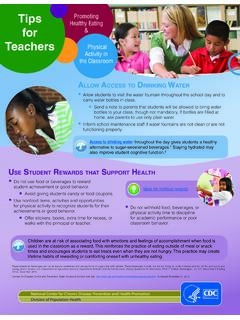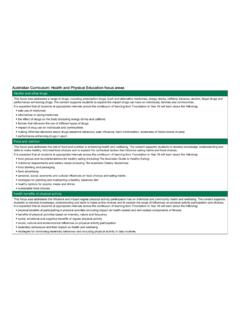Transcription of Understanding Eating Disorders - Center for Young …
1 Understanding Eating Disorders :A Guide for Parents and FamiliesCenter for Young Women s HealthYoung Men s Health InitiativeIN APPRECIATIONWe would like to recognize our dedicated team of original authors: Blair Ballard, Kendrin Sonneville ScD, RD, LDN, Abigail Hammond MS, RD, LDN, Phaedra Thomas RN, BSN, Amanda Kohn, BFA, Sarah Pitts, MD, and Melissa Freizinger, PhD. Additional revisions made by Katrina Schroeder Smith, RD, LDN, Amanda Waldron, RD and Anna thanks to Jean Emans, MD and Sara Forman, MD for their valuablefeedback and for their commitment to educating Young people and their families about Eating Disorders .
2 This book is dedicated to our patients and all the other adolescents and Young adults who are struggling with Eating staff of the Center for Young Women s Health gratefully acknowledges the Boston Children s Hospital League for funding this project and our patients and families who have taught us so updated May 2019 Eating Disorders affect millions of Young people and adults around the world of all races and ethnic backgrounds. There are different types of Eating Disorders including: anorexia nervosa (AN) bulimia nervosa (BN), binge Eating Disorders (BED), avoidant restrictive feeding intake disorder (ARFID), and other specified feeding and Eating Disorders (OSFED).
3 Although some of the symptoms of the different categories of Eating Disorders overlap, a person can only have one Eating disorder diagnosis at a time. Eating Disorders are found everywhere, particularly in cultures that focus on weight and body image. It s not uncommon for negative body image and unhealthy Eating behaviors to go together. But Eating Disorders are about more than weight stress, trauma, loss of control, and participation in certain sports can all contribute to Eating Disorders . The dedicated team of authors wrote this booklet for parents because Eating Disorders have serious health consequences that can be helped or prevented with early treatment.
4 Fortunately, recovery is likely with the help from specially trained health care providers and a supportive family. We hope this information will help you as a parent to understand what Eating Disorders are, the different kinds of treatment, the recovery process, and how to help your child. This booklet also includes advice for parents written by a Young woman who has recovered from an Eating disorder, and reflections written by her mom. Understanding Eating Disorders :A Guide for Parents and FamiliesWhat are Eating Disorders ?
5 1 Causes of Eating Disorders 3 Warning Signs and Symptoms of Eating Disorders 5 Health Consequences of Eating Disorders 7 Helping Your Child Prepare for an Eating Disorder Evaluation 9 The Treatment Team 13 Treatment Options for Eating Disorders 15 Therapy for Eating Disorders 19 What is healthy Eating ? 23 healthy Exercise 27 Yoga 31 Body Image and Self Esteem 35Do s and Don ts for Parents 37 What I Wish My Parents Knew 41My Daughter s Journey 45 Glossary of Terms 47 Resources 51 TABLE OF CONTENTSE ating Disorders are complex medical and psychiatric illnesses that affect a person s physical and mental health.
6 Involving intense emotions and disordered behaviors related to food. These are serious illnesses and can be fatal if left are several types of Eating Disorders and it s easy to get them confused because symptoms may overlap. The different types include anorexia nervosa, avoidant/restrictive food intake disorder (ARFID), bulimia nervosa, binge Eating disorder, and other specified feeding and Eating Disorders (OSFED).Anorexia Nervosa (pronounced: an or rex e ah nerve o sah) involves significant weight loss, lack of appropriate weight gain or refusal to gain weight, and a distorted body image.
7 People with anorexia drastically limit their food intake (known as food restriction, which also involves cutting out certain foods/food groups) and have an intense fear of gaining weight, even though they may be underweight or have lost a significant amount of weight. Anorexia nervosa often presents during early adolescence (11 13 years of age) or during the later high school years (17 18 years of age), when a teen is preparing to go to college, but can occur in people of any age. Someone with anorexia may or may not binge and/or Food Intake Disorder (ARFID) is a feeding and Eating disorder characterized by limiting intake of food or food groups without a fear of weight gain.
8 This Eating style can lead to consequences such as weight loss, inadequate growth, or a significant nutritional deficiency. ARFID often presents during early adolescence, with the average age of onset being 12-13 years old. Unlike people with other Eating Disorders such as anorexia nervosa, individuals with ARFID do not have significant body image Nervosa (pronounced: bull e me ah nerve o sah) (pronounced: bull e me ah nerve o sah) involves cycles of binge Eating followed by a purging behavior. People with bulimia will eat an unusually large amount of food in a short period of time and then purge by vomiting, using laxatives, enemas, or diuretics, or by exercising excessively as a way to counteract the binge and avoid gaining are Eating Disorders ?
9 1 Binge Eating disorder involves Eating an unusually large amount of food in a short period of time. People with binge Eating disorder feel out of control during these Eating episodes and often feel intense shame or guilt afterwards. People with binge Eating disorder do not purge after specified feeding and Eating Disorders (OSFED) involve some combination of symptoms of the other Eating Disorders such as an intense fear of weight gain and preoccupation with food (thinking about food or having food related thoughts most of the day) but do not meet full criteria for another Eating disorder.
10 Many individuals with OSFED have a variety of Eating disorder symptoms. Disordered Eating is a term used to describe the condition when someone doesn t have all the symptoms of a specific type of Eating disorder, but their Eating patterns and behaviors put them at risk for developing an Eating disorder. For example, extreme dieting or orthorexia (an obsession with healthy Eating ) can lead to an Eating rates or how often Eating Disorders occur varies with each disorder and are difficult to pinpoint as many people suffering may never seek treatment and/or be diagnosed.









